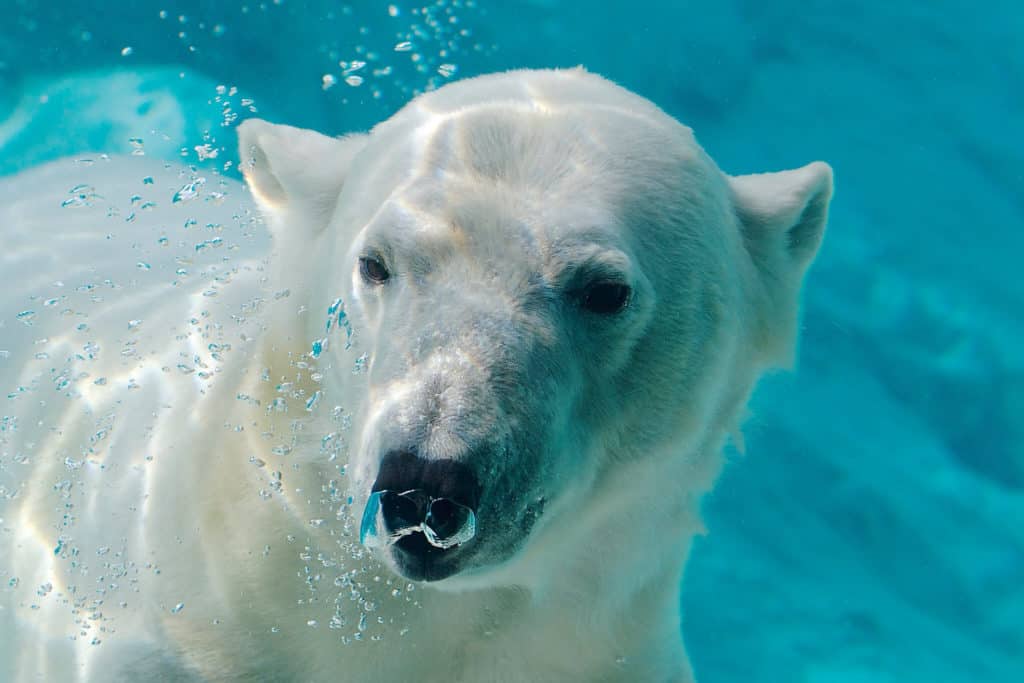Polar bears are remarkable animals that are known to be large, fierce predators that dominate in the icy Arctic region.
They are perfectly adapted for life in the cold, with black skin, thick fur, and the ability to thermoregulate allowing them to withstand incredibly cold temperatures.
Today, we’re going to take a closer look at the polar bear and how they handle water, as well as answer can polar bears swim?
In short, yes, polar bears can swim. They are excellent swimmers that can swim long distances and for many hours to get from one icecap to another.
Can Polar Bears Really Swim?
Polar bears are excellent swimmers, they don’t mind if the water is cold and have specially adapted paws that are giant and act as paddles to pull them through the water.
These giant bears can reach impressive speeds of 6mph and be surprisingly agile whilst swimming, allowing them to catch their prey should it slip into the icy water.
Polar bears are strong swimmers that do not hesitate to swim long distances between icecaps in search of food.
Their thick fur insulates them from the cold and their large paws are perfect for swimming. Their nostrils also fully close whilst swimming which prevents them from accidentally inhaling any water.
Adult polar bears have a large lung capacity too and can stay submerged under the water for around 3 minutes.
How Long Can Polar Bears Swim For?
It may come as a surprise to learn that polar bears are capable of swimming incredible distances without stopping.
A new study published in Zoology recorded polar bears regularly swimming 30 miles (48 kilometers) and in one case as far as 220 miles (354 kilometers).
Researchers believe that the polar bears’ incredibly strong swimming may allow them to survive as sea ice vanishes due to climate change.
As the weather in the Arctic gets warmer and the ice starts to melt, polar bears rely on their swimming in order to hop between ice caps and search for prey.
Why Are Polar Bears Good Swimmers?
Polar bears are categorized as marine mammals, which means they rely on the ocean and other marine ecosystems for their survival.
These bears really do rely on the ocean to survive, they lurk above seal breathing holes in hopes that an unsuspecting seal will surface and then they make their move.
They spend a significant amount of time in the water hunting seals and whales, which means they need to be exceptional swimmers in order to eat and provide for their young.
Polar bears have a thick layer of fat that keeps them insulated from the icy Arctic waters and they also have the ability to thermoregulate.
They have giant paws and strong legs that they use as a propeller to push themselves through the ocean whilst their back legs steer them.
Can A Polar Bear Swim Without Stopping?
Polar bears can swim for days on end in open waters without rest new research has found.
The study tracked 52 female polar bears off Alaska between 2004 and 2009 and found that around a third of those bears made swims of more than 30 miles during that period.
Researchers from the US Geological Survey used GPS tracking collars to watch the bears’ movements, using only female bears as the male’s necks were too large for the tracking collars.
The study witnessed 50 swims averaging about 96 miles with one bear swimming almost 220 miles. The study reports that about 40 percent of the tracked bears took “marathon swims”.
It’s still unclear why polar bears make such large swims, but it’s clear from this study that polar bears are exceptional swimmers and are powerful enough to swim for days without rest.
Can Polar Bears Drown?
Polar bears, as with other mammals breathe through their lungs which means that they can only hold their breath for a certain amount of time before they are required to surface and breathe.
They are exceptionally strong swimmers but if they found themselves caught up in a fishing net or trapped out in open waters during a strong storm, they could drown.
Unlike fish, they do not have gills or any method of extracting oxygen from the water whilst submerged, so drowning although unlikely is possible for polar bears.
Final Thoughts
Can polar bears swim? Absolutely! Polar bears are exceptionally strong swimmers that can swim for days on end in open water without rest.
They are perfectly adapted for life in the cold weather as they have thick fur, a layer of fat as well as the ability to thermoregulate.
This means that the cold water does not affect the polar bears’ bodies and they are able to swim even when the water is freezing cold.
New studies have shown that polar bears are much stronger swimmers than they are given credit for.
After all, they are marine mammals that heavily rely on the ocean for food, so it makes sense that they should be great swimmers.
Hopefully, you’ve enjoyed this post today and have learned something new about polar bears swimming.
Thanks for taking the time to read this article and feel free to stick around to learn more about polar bears and other marine wildlife.

Hi, I’m George – the founder of MarinePatch. I created this blog as marine wildlife has been my passion for many years. I’ve spent over a decade in the marine wildlife industry and spent years out in the field conducting research. In today’s modern world, an online blog is the best place for me to share my findings and reach as many people as possible to help educate and inspire others. Enjoy your time here and you’re welcome back anytime!

